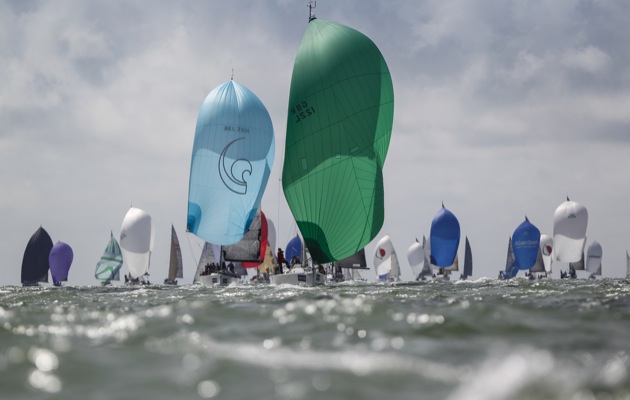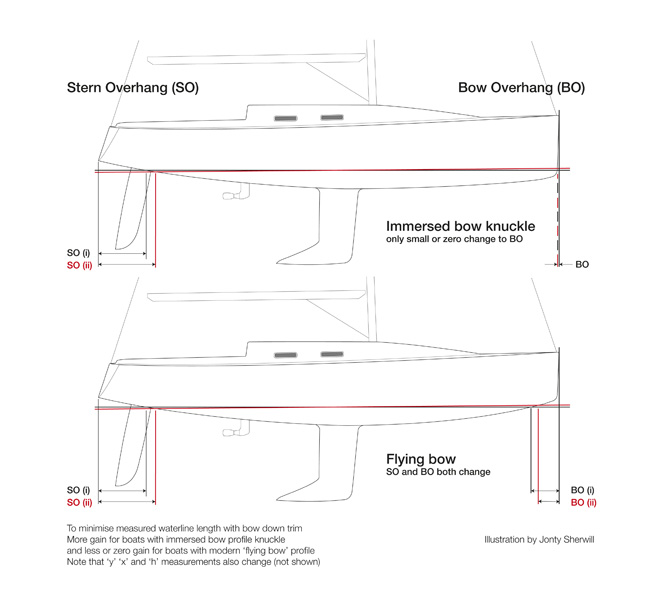Designers work hard to create fast yachts, but much can be done to optimise a boat’s IRC rating. Jonty Sherwill asked measurement experts for their 5 tips
It’s the same type of boat going the same speed, but how come their IRC rating is so much lower than yours? Although getting your rating as low possible is important, making a boat go faster with little additional rating penalty can be even more effective.
No rating system can be perfectly fair to all boats in all scenarios and it’s important to know what a particular measurement rule ‘likes’ before making a change. Some argue that optimising your boat to be faster than your main rivals will put you in clear air ahead of the pack, while others recommend being closer to them for a better chance of beating them tactically.
For some events an endorsed IRC certificate is stipulated, requiring weighing and check measurement by an official measurer. Displacement, for example, can vary markedly from the builder’s stated figure and an endorsed certificate also provides peace of mind that your rating is accurate and that you are not cheating unintentionally.
Although this process adds some expense, endorsement can sometimes deliver a nice surprise with a lower rating, but overall the drive for simplicity has made IRC measurement clearer for all, from bilge keelers at club level right up to grand-prix racing yachts.
Just like yacht design, measurement rules evolve year on year so if a competitive rating is important to you it helps to understand these subtle changes.
But before spending your hard-earned cash you should not ignore one speed boost that the crew can achieve in a single team- building weekend – fairing the bottom!
1. Sail measurement
The simplest and most frequently overlooked way of reducing your rating is to measure your sails. Laminate sails shrink and should be remeasured each season while others develop minute creases that reduce the cross sail measurement. Spinnakers should be dry and salt-free and if possible warm as this can help reduce the measured area.
Boats on one-design ratings can benefit from getting individual ratings for open class racing as the sail measurements on their standard IRC certificate will be the class maximum sizes. Sails are generally made at least a few millimetres smaller, if not more, to make sure they will be legal.
2. Spars and bands
Another simple, but effective check and potential saving is to ensure that black bands are painted on – one at the top of the mast and one at the end of the boom – to match the maximum hoist and maximum outhaul position for your mainsail. Otherwise these measurements are taken to the masthead sheave and the extreme end of the boom – costly in rating.
Carbon spars and composite rigging attract some rating penalty, but the improvement to a boat’s dynamics can be significant, especially on larger yachts.
3. Waterline length
Waterline length is a fundamental of boat speed so a short measurement is better. Overhangs should be measured when the yacht is empty and dry to avoid a penalty, and with the fuel tank drained. The weight of fuel is deducted, but no allowance is made for overhang difference.
Consider the positioning of the battery. If the bow knuckle is immersed, moving weight forward will lift the stern with very little penalty on the bow overhang. Modern yachts with knuckle out of the water will not benefit much as the canoe body fore and aft is similar.
4. Displacement
The boat will have been designed to a target displacement, but that doesn’t always mean it’s the ideal weight for the best handicap. A light boat with lots of crew may go well to windward, but if two-handed or single-handed racing is your plan then you might consider putting more lead in the bilge.
Although this increases waterline length, the result may be a more competitive and seakindly boat. But always ask for professional advice. Increasing the weight of the keel can have serious structural implications and is likely to affect the hull factor.
5. Sail inventory
Adding more sails can improve all-round performance; an extra spinnaker, particularly on larger yachts, is seen as generally worthwhile, while jib tops and Code 0s are free of rating ‘tax’. For inshore racing your money might be better spent on a new spinnaker and, while some think asymmetric boats have an advantage offshore, adding spinnaker and genoa staysails may help offset this.
For jibs, short-handers can choose to declare a No 3 as the biggest headsail to reduce rating at no cost, but light airs performance will be affected. A purpose-designed, in-hauled, non-overlapping headsail of similar size would address this.
Note: The information provided here is based on opinions from various sources and we recommend that advice is obtained from industry professionals, eg your sailmaker, yacht designer, surveyor or measurer, as part of any rating optimisation. Trial certificates can be obtained from the RORC Rating Office, but are not encouraged on a regular basis.
This is an extract from a feature in the February 2015 issue of Yachting World






